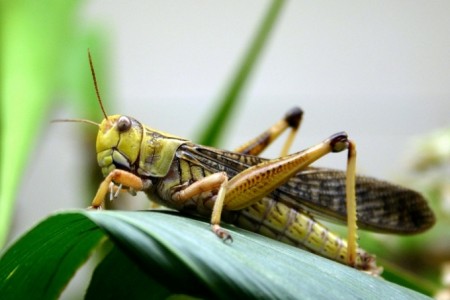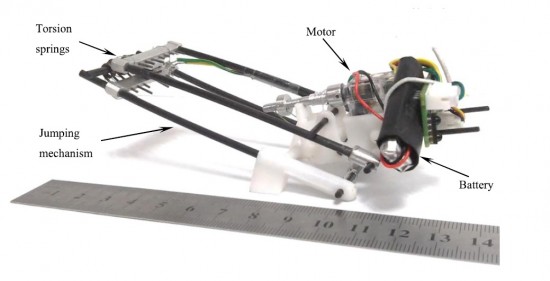December 19, 2015 – The animal kingdom has invented all kinds of means of locomotion. From multi-legged centipedes to eight-legged arthropods, six-legged insects, four-legged mammals and two-legged birds and humans, we can find many variations in the means to get moving. One of the strangest is jumping. Kangaroos do it. So do frogs and toads. And then there are grasshoppers and locusts.
Jumping has considerable advantages when encountering impediments in an animal’s path. A single leap can get you over and elsewhere. That capability is the biomimetic inspiration for a team of robot designers at Israel’s Tel Aviv University and Ort Braude College. They have designed and built a locust-inspired robot weighing a mere 23 grams, and just under 13 centimeters (5 inches) in length. The robot can leap to heights of over 3.3 meters (11 feet) and cover a distance horizontally of just under 1.4 meters (4.5 feet).
Pictured below, the robot goes by the name TAUB and features a plastic body constructed using a 3D printer. The legs are carbon rods. The propulsion spring is made of steel wire. Power comes from a tiny on-board battery. And a small micro-controller allows handlers to guide the robot remotely.
TAUB biomimicry is fashioned around grasshopper and locust locomotion. The rear legs of these insects are long and muscular and are folded. When the extensor muscles contract the legs jerk backwards and propel the insect upward and forward. The robot acts similarly. Its energy is stored in the springs which act as the extensor muscle and when the leg joint unlocks that energy is rapdily released causing the body to move upward and forward.
TAUB right now is more like a grasshopper than a locust. Locusts are close kin to grasshoppers but they do one thing that grasshoppers tend not to do. That is rely on their wings to extend their range dramatically. TAUB’s creators want to add that capability to their invention to give the robot a gliding mechanism for extended range. And if they add a small on board camera you could imagine this robot serving many practical applications from emergency search and rescue in rough terrain, to battlefield surveillance in environments where other robots would fear to tread.
For the details on TAUB go to the journal IOPScience. The inventors have authored a paper that was published there on November 25.










